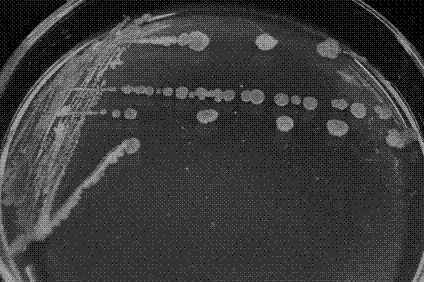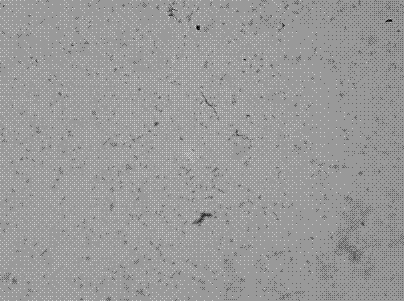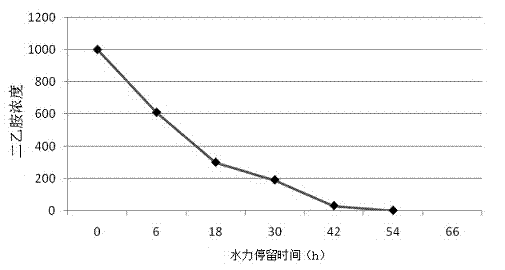Diethylamine degradation pseudomonas strain EYA-2 and application thereof
A technology of EYA-2 and Pseudomonas, applied to bacteria, fixed on/in organic carriers, water/sludge/sewage treatment, etc., can solve problems such as high cost and secondary pollution, and achieve production Low cost, reduce wastewater treatment cost, and protect the ecological environment
- Summary
- Abstract
- Description
- Claims
- Application Information
AI Technical Summary
Problems solved by technology
Method used
Image
Examples
Embodiment 1
[0022] Example 1 Isolation and identification of diethylamine-degrading strain EYA-2
[0023] Take 1.0ml of diethylamine-enriched bacteria solution, add 9.0ml of sterile water, and mix well to make 10 -1 The rich solution, and then draw 1.0ml prepared 10 -1 The enrichment solution was added to 9.0ml sterile water, mixed thoroughly to make 10 -2 The enrichment solution, and so on, carry out gradient dilution on the enrichment solution. Draw 0.1ml of the diluted solution of each gradient and spread it on the inorganic salt solid medium containing 100mg / L diethylamine. The formula is: 1.5 g K per liter 2 HPO 4 , 0.5 g KH 2 PO 4 , 0.2 g MgSO 4 ×7H 2 O, 1.0 g NaCl, 1.0 g (NH 4 ) 2 SO 4 , 20g agar, pH 7.0, cultured at 30°C for 7 days. After 7 days, pick a single colony from the above inorganic salt solid medium, culture in 5ml LB liquid medium for 24 hours, centrifuge at 8000r / min for 2min, pour off the supernatant, add 5ml of sterile Shake well with water, centrifuge at...
Embodiment 2
[0024] Example 2 The method for preparing immobilized pellets from bacterial strain EYA-2
[0025] 1) Use an inoculation loop to pick a small amount of bacterial strains on the slant medium and inoculate them in LB liquid medium at 30°C and 160r / min for shaking culture to the logarithmic phase;
[0026] 2) Centrifuge the above cultured bacterial solution at 8000r / min for 2min, discard the supernatant, add the same volume of sterile water, shake well and centrifuge at 8000r / min for 2min, wash twice in this way, and use the same volume Suspended in sterile water to make a bacterial fluid.
[0027] 3) Take 0.7ml of bacterial liquid and 20ml of 4% sodium alginate solution and mix at room temperature, then use a syringe to drop the mixture into 3% CaCl at room temperature 2 The solution was cross-linked and calcified at 4°C for 6 hours to obtain calcium alginate gel-immobilized beads, which were washed twice with sterile water and stored at 4°C for later use.
[0028] The LB medi...
Embodiment 3
[0029] The application method of embodiment 3 immobilized bead in the degradation of diethylamine
[0030] First, aerate the immobilized pellets in wastewater for 12 hours to activate. During the activation process, the water temperature is 28±2°C, the aeration rate is 1.2L / min, and then the temperature is 28±2°C, and the pH value is 6.8-7.2. Under certain conditions, when the influent concentration of diethylamine is lower than 1200mg / L, 175ml of immobilized pellets are used for each liter of diethylamine wastewater, and at the same time, the hydraulic retention time is 54h. In this case, diethylamine The removal rate of amine is above 97%, which has a good removal effect, as shown in image 3 and Figure 4 shown, where image 3 It shows that when the influent concentration of diethylamine is lower than 1200mg / L, every liter of diethylamine wastewater is treated with 175ml of immobilized microbial pellets. At the same time, the hydraulic retention time is 54h, and the remov...
PUM
 Login to View More
Login to View More Abstract
Description
Claims
Application Information
 Login to View More
Login to View More - R&D Engineer
- R&D Manager
- IP Professional
- Industry Leading Data Capabilities
- Powerful AI technology
- Patent DNA Extraction
Browse by: Latest US Patents, China's latest patents, Technical Efficacy Thesaurus, Application Domain, Technology Topic, Popular Technical Reports.
© 2024 PatSnap. All rights reserved.Legal|Privacy policy|Modern Slavery Act Transparency Statement|Sitemap|About US| Contact US: help@patsnap.com










